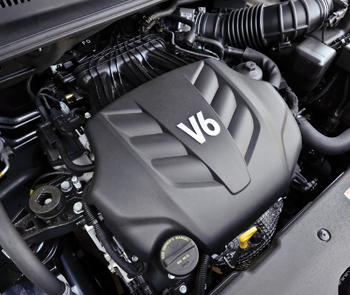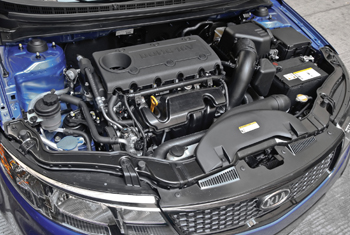We’ll be taking a look at the Kia line of cars and SUVs this month with an eye toward driveability issues and check engine light concerns.
My first point is that there should be no trepidation when a Kia finds its way to your bay. Kias enjoy a solid dealer network, good parts availability and a no-charge website for repair information (www.kiatechinfo.com), so there is no reason that you shouldn’t welcome them into your shop.
You will be hearing the familiar complaints — no power, rough run, misfires and hard start. These complaints may set a check engine lamp or it could be that the only symptom is an illuminated check engine light with no apparent driveability issue.
As always, the first step in a successful repair is for the service writer to get as much information as possible from the customer about the problem and the vehicle history. This is particularly important with intermittent problems. If the check engine lamp is lit, we have to determine if it came on as a result of the problem that concerns the client, or whether it has been on for months with no obvious problems.
Kias are just like any other car; it takes a diagnostic plan to get you to a successful repair. The first step is to retrieve any codes or confirm that there are none. You’re ahead of the game if you have an enhanced scanner, but even the most basic machines will provide you with some live data that should be looked at. It takes only a few minutes to get some confirmation that the main sensors are reporting as expected.
The next step depends on the problem. If you’re faced with an obvious misfire issue, there is no need to drive the car and, for the good of the cat convertors, we probably shouldn’t. There should be a code set indicating the cylinder at fault; we still confirm the offending cylinder by disabling the spark or preferably the fuel before continuing the diagnosis.
Once the offending cylinder is confirmed, take a look at the spark plug for the next clue. If spark is present, the plug will appear dry and clean, while a damp or wet plug tells you the fuel is there and it’s not getting burnt.
This is also the time to evaluate the condition of the plugs and make a judgment on where this car is on the maintenance schedule. Many Kias call for 30,000-mile plug replacement, and that often gets overlooked as our customers are becoming used to extended change intervals. This is also the time to test compression; no point looking for a spark or fuel problem in a cylinder with a mechanical problem.
The ignition systems on Kias are conventional and won’t present any special diagnostic problems. But, on the coil-on-plug cars, if you suspect a bad coil, the best course of action is to switch it with a cylinder that’s running.
DON’T FORGET THE BASICS
We all know that not all the driveability problems we’ll see are as straightforward as misfires. Some of the more common ones we’ll face include a tip-in hesitation. Again, don’t overlook the basics. While the problem of cracked intake hoses have been around for years, you still hear stories of guys getting stuck on this issue.
If you have a car that dies when the throttle is tipped in, and may have a system lean code, be sure the hose isn’t cracked; if you’re in doubt, remove the hose to give it a proper inspection. While you’re there, check the condition of the air filter and throttle body before performing any service required. If it’s a late-model drive-by-wire vehicle, be sure to follow the proper precautions to protect the electronics in the throttle.
I mentioned a lean code and, while an intake hose can certainly cause the problem, it’s not the only reason for that code. A more common failure is a dirty air mass sensor not reporting the correct mass of air being drawn into the engine, resulting in the system being so lean that the oxygen sensors are asking for more fuel than expected.
If you’re working on a V6, you may get a lean code on one bank. Don’t let this send you down the wrong path; check the long-term fuel trim numbers. Similar trim numbers should have you looking for a problem that will affect both banks. As you would expect, the lean code will be set before the air mass sensor would cause a no-power complaint, but we still see plenty of owners who don’t find their way to the shop until the power is affected.

POOR-POWER COMPLAINTS
When looking for a poor power complaint, again, it’s time to hook up the scanner for a road test, making note of calculated load and airflow. At wide open throttle under load, look for a load number near 100% and an airflow voltage output near 5 volts (refer to the Kia website for the exact numbers).
If you’re not reaching those numbers you can clean the sensor, but a new unit would probably be the best course of action. There have also been some reports of occasional stalling being traced back to air mass sensor issues. To confirm this condition, shake the sensor with the engine running to see if it will stall.
You don’t want to overlook the possibility of a plugged cat converter as the cause of the poor power complaint. Kias have had some problems with cats that will usually give the tech some indication of the cat being plugged but, if there is any doubt, take the time to remove the front sensor and check for excessive pressure.
Speaking of catalytic converters, keep them in mind when dealing with a no-start condition. You would think the low power caused by a clogged cat couldn’t be overlooked, but we’ve seen more than a couple of Kias that wouldn’t start as result of the cats being too clogged. If you have one that seems to crank normally, has fuel and spark, but looks to be flooded, pull the O2 sensor and see if it doesn’t start. I know I’ve been surprised more than once on this one.

CAM AND CRANK SENSOR CODES
Kias are also not immune to the relatively common cam and crank sensor codes. Often presented as a stalling condition, they will often start right back up and can be driven in. In this case, if there’s a sensor code present, we just change the sensor. On the crank sensors, it’s not uncommon for the harness to be damaged by the timing belt if the harness is not routed properly. There are also numerous reports of the cam sensor being damaged during water pump replacement.
On the four-cylinder cars, after broken belts are replaced, there have been reports of crank sensor failures caused by the debris from the old belt not being thoroughly removed. Be sure there is nothing jammed between the sensor and reluctor. If the sensor is removed, be sure it’s installed facing the proper direction; it’s easy to install it “backward,” so be sure the sensor is facing the reluctor.
In these articles and in my shop, I’m always talking about work habits. As a shop owner, nothing is more frustrating than to have a customer be willing to replace the timing belt and pump as preventive maintenance, only to have our mistake cause him to get stuck on the road. Always watch for the things that can bite you, or, more importantly, your customer. A few minutes spent double-checking your work is time well spent, when compared to the hours it takes to fix it later, not to mention the disappointed customer.
Another cam sensor issue that could give you fits on the Rio involves the reluctor coming loose on the end of the camshaft, causing a sporadic spark as well as disturbing the timing. So as you’re changing the sensor, be sure that the reluctor is secure.
NO-SPARK CONDITIONS
We talked a little about no starts but not about a no-spark condition. In this case, there should be a code to help you go in the right direction. We talked about the cam and crank sensors, and how any code there should lead us to a confirmation test at the sensor; remember, some of these vehicles have balance belts that can take a crank sensor out pretty quickly.
A code you may not be familiar with is a P0320 Ignition Failure Sensor Circuit Malfunction. The Ignition Failure Sensor is responsible for keeping track of the voltage drop on the positive side of the coils so the ECU can monitor the coil function. In order to perform this function, the fused power to the coils has to pass through this device, and the code is set when the ECU doesn’t see an ignition signal. This device is also used as a tachometer amplifier.
There have been reports of these sensors failing and causing no spark, no battery power at the coil. Keep in mind that this circuit is fused, so don’t overlook the basics if there is no voltage going into the sensor; there can’t be any output.
While not a common problem, there have been some reports of harness problems on the Rio. Some techs have found “opens” in the power leads feeding the coils, causing an intermittent misfire that I’m sure was giving them fits. Others have reported problems in the injector and ground circuits on other models. Like I said, this is not a common issue, but it pays to keep it in mind if you’re dealing with a tough problem.
I’ll leave you with my usual comments. If you’re a good tech or employ one, there’s no reason you can’t handle the same repairs on the Kia line of cars, vans and SUVs that you do on any other brand. The service information and repair tips you’ll need are as close as the nearest computer for little or no cost. Kia provides the service information, TSBs and more on its no-charge www.kiatechinfo.com website. Repair tips and help from other techs are also available on iATN and parts supplier community forums.
The information is out there; you just have to use it.




